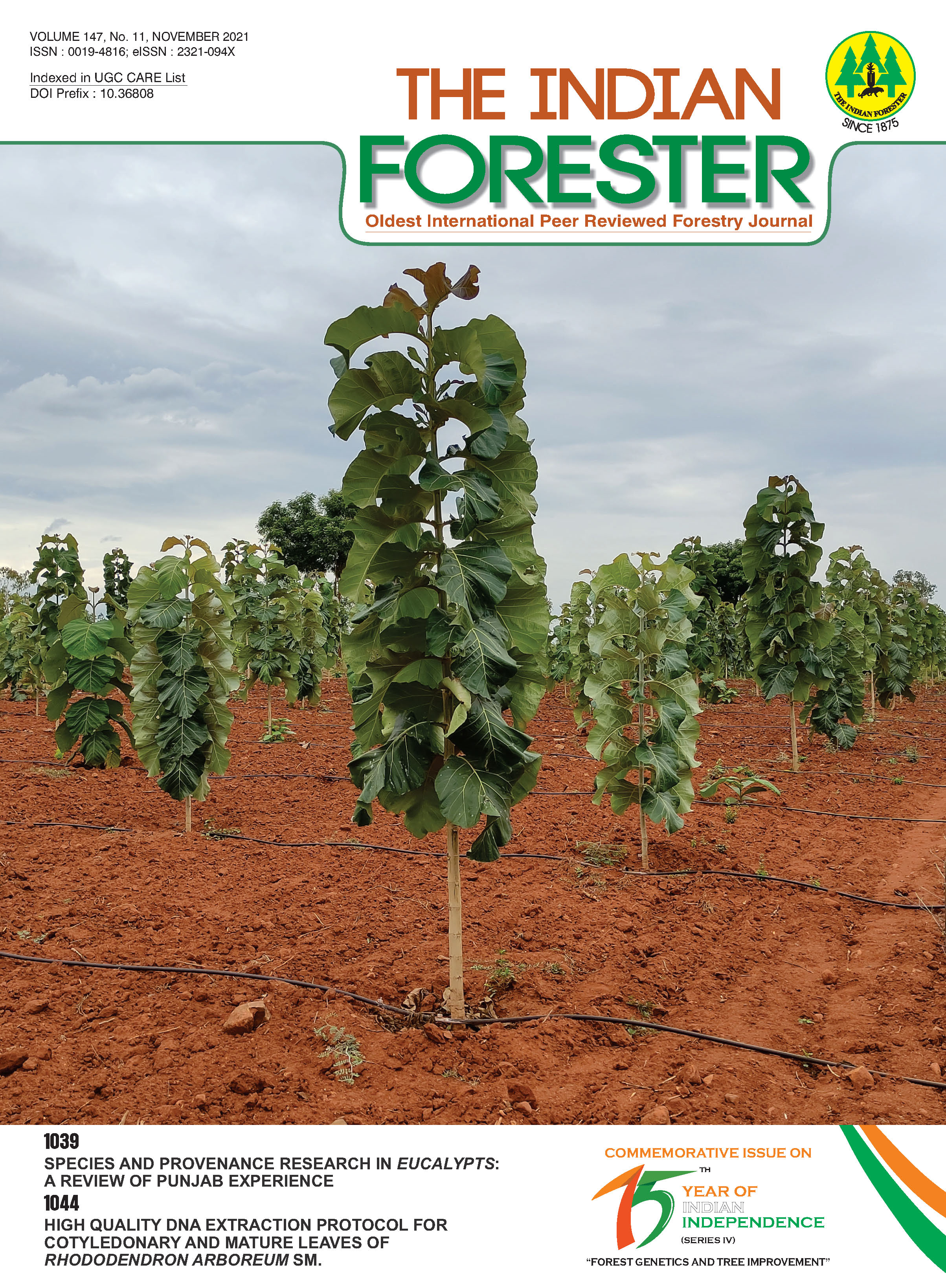Variation in Growth, Biomass Production and its Components in Eucalyptus Clones
DOI:
https://doi.org/10.36808/if/2021/v147i11/155084Keywords:
Biomass Production, Components, Eucalyptus Clones and Growth.Abstract
Eucalypts are among the most widely cultivated forest trees in the world under a range of different climates for products that include pulp, paper fuel wood and solid wood products such as poles, furniture and construction timber. Large scale plantations have been raised in government owned and private farm lands; the planting is continuing. Productivity and profitability of plantations of Eucalyptus have been revolutionized with the development of genetically improved, fast growing and high yielding clonal planting stock of Eucalypts. Eucalypts clonal planting has been said to have advantages which includes quick provision of benefits associates with fast growth, short rotation for production of pulp wood (of around 70 t ha-1 in 6 years) ready marketing and easy establishment and less maintenance needs. Clonal planting one among the approach for management of water and nutrients compared to the other conventional strategies. Studies relating to clonal difference and evaluation for dry matter production will help to overcome productivity loss due to deficit rainfall and optimum utilization of available natural resources for higher wood production. The present study was carried out to test the hypothesis that there exists a clonal variation in growth, biomass production and components and the present study gives an insight in to clonal variation with reference to growth, biomass production and components.References
and net annual primary production in forest ecosystem of the world In: Forest biomass studies: College of life sciences and Agricultural Experimental station, University of Maine, USA.
Bhatia C.L. (1984). Eucalyptus In India - Its Status and Research needs, Indian Forester, 110(2):.91-96.
Boland D.J. (1981). Eucalyptus seed for Indian plantations from better Australian natural seed sources. Indian Forester, 107(3): 125-134.
Buvaneswaran C. (2004). Studies on biomass production relations in Tectona grandis L. f plantations at different ages in Tamil Nadu, Ph. D. Thesis, FRI University, Deharadun.
Chandra J.P. and Yadava M.P.S. (1986). Clonal propagation of Mysore gum (Eucalyptus hybrid). Indian Forester, 112:783791.
Davidson J. (1995). Ecological aspects of Eucalypts. In: Proceedings of Regional expert consultation on Eucalyptus. Vol. 1 FAO Regional Office for Asia and Pacific, Bangkok, Thailand.
Dhyani S.K. Narain P. and Singh R.K. (1990). Studies on root distribution of five multipurpose tree species in Doon Valley, India. Agroforestry systems, 12: 149-161.
Ginwal H.S. (2009). Provenance and family variation in growth performance of E. tereticornis (Sm.) in a provenance cum progeny trial in Midnapore, India. Forest Ecology and Management, 01/2009; DOI:10.1016/j.foreco.2009.09.009.
Hubbard R.M. Bond B.J. and Ryan M.G. (2010). Evidence that hydraulic conductance limits photosynthesis in old Pinus ponderosa trees. Tree Physiology, 19: 165-172. Indian Council of Forestry Research and Education. Frequently asked questions on Eucalyptus. ICFRE Webmail.
Jambulingam R. (1989). Growth and biomass of Casuarina equisetifolia forst. In different ecosystem. Ph. D thesis. Department of Forestry, TNAU, Tamil Nadu.
Kumar R. and Bangarwa K.S. (2006). Clonal evaluation in Eucalyptus tereticornis Sm. Environment Ecol, 24 (4): 1188–1191.
Kumar A. Luna R.K. Parveen and Kumar V. (2010). Variability in growth characteristics for different genotypes of Eucalyptus tereticornis (SM.). Journal of Forestry Research, 21 (4): 487-491.
Lal P. (2005). Performance of Eucalyptus clones in Punjab. Proc.; National Symposium on Exotics in Indian Forestry, held at Department of Forestry and Natural Resources, PAU. Ludhiana, from March, 15–18, p. 45.
Onyekwelu J.C. Stimm B. and Evans J. (2011). Review Plantation Forestry. In Günter et al. (Ed.), Tropical Forestry 8: Silviculture in the Tropics (pp. 399-454). Berlin: SpringerVerlag.
Parveen A. Kumar V.K. Sharma and H.S. Ginwal. (2010). Sustained Hybrid Vigor in F1 Hybrids of Eucalyptus torelliana F.v.Muell x E. citriodora Hook. World Applied Sciences Journal, 11(7): 830-834.
Paulo Ricardo Gherardi Hein, Loic Brancheriau, José TarcÃsio Lima, Antônio Marcos Rosado, Joseph Gril and Gilles Chaix. (2010). Clonal and environmental variation Ferraz, J. M. et al. of structural timbers of eucalyptus for growth, density, and dynamic properties. Cerne, Lavras, 16: 74-81.
Singh V. and Tokey O.P. (1995). Biomass and net primary productivity in Lecuaena, Acacia and Eucalyptus, short rotation, high density (energy) plantations in Arid India. Journal of Arid Environments, 31(3): 301-309.
Singh Y.P. Gurubachan Singh and Sharma D.K. (2010). Biomass and bio energy production of ten multipurpose tree species planted in sodic soils of Indo gangetic plains. Journal of Forestry Research, 21 (1): 19-24.
Srivastava A.K. (1994). Productivity and economics of some commercially important forest trees. Indian Forester, 120 (1): 12-29.
Stape J.L. (2002). Production ecology of clonal Eucalyptus plantations in North Eastern Brazil. D. Phil Thesis. Colorado University, USA. Pp 237.
Verma V.P.S. Tandon V.N and Rawat H.S. (1987). Biomass production and plant nutrient volume distribution in different aged plantations of Casuarina equisetifolia in Puri, Orissa. Indian Forester, 113 (4): 273-279.
Vidyasegaran K. (2003). Biomass production and nutrient cycling in Casuarina equisetifolia J.R & G. Frost. Plantations in the coastal plains in Kerala. Ph. D thesis. FRI University, Dehra Dun.
Wang J.K. Zhong A.L. Comeau P. Tsze M. and Kimmins J.P. (1995). Above ground biomass and nutrient accumulation in an age sequence of aspen (Populus tremuloides) in the Boreal white and black spruce zone, British Columbia. Forest Ecology and Management, 78: 127-138.
Xiaoyong Mo, Shiyao Peng, Teng Long, Wenping Chen and Xiaohong Yang (2003). Important traits and combined evaluation of Eucalyptus clones. Ed. Eucalyptus Plantations: Research, Management and Development. Proceedings. Edited by Run-Peng Wei and Daping Xu, World Scientific Publishing Co. Pvt. Ltd. 5 Toh Tuck Link, Singapore–596224.
Zabek L.M and Prescott C.E. (2006). Biomass equations and carbon content of aboveground leafless biomass of hybrid Poplar in Coastal British Columbia. Forest Ecology and Management, 223: 291-302.
Downloads
Downloads
Additional Files
Published
How to Cite
Issue
Section
License
Unless otherwise stated, copyright or similar rights in all materials presented on the site, including graphical images, are owned by Indian Forester.





